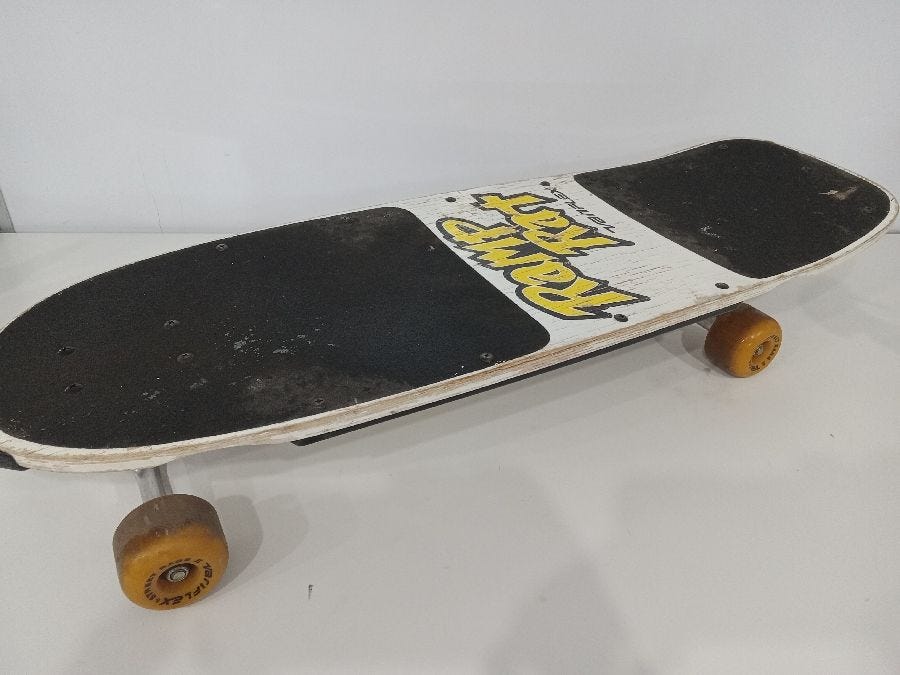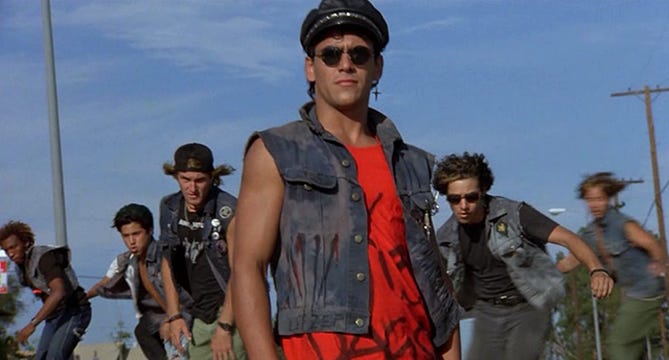The Variflex Skateboard Miracle
I didn't believe it could fly until I saw it with my own eyes
When skateboarding exploded in the 1980s, kids either rode professional brand skateboards or inexpensive pieces of crap. My first skateboard, made by Variflex, was an inexpensive piece of crap. Variflex skateboards resembled quality skateboards from a distance but the minute you touched one their true crappiness was revealed. They were heavy, their wheels didn’t roll well, and they were adorned with generic graphics that adults in suits thought kids would like. While name brand skateboards had to be purchased at skate shops, the mall, or ordered through skate magazines, Variflex skateboards were readily available at Walmart, Kmart, and Toys “R” Us.
I don’t remember where my first skateboard came from, but I do remember it was made by Variflex. It was black with purple wheels and weighed three times as much as a normal skateboard. On the bottom was a picture of a skeleton, maybe the Grim Reaper, along with a snake. The artwork looked like a caricature of a tattoo a villain in a comic book might have.
The first trick every kid with a skateboard had to learn was the ollie. Rodney Mullen technically didn’t invent the ollie but he was the first one to perform it in a competition in the early 80s and introduced it to the larger population. From there the trick began appearing in skateboarding magazines, and the rest is history. The first time you see someone performing an ollie it feels like a magic trick. Ollies involve leaping into the air and somehow getting your skateboard to follow you up and over things.
Based on this video you would think the average kid with even the tiniest bit of skill and determination could learn how to ollie over a milk crate in a single afternoon. That was not my experience. My friends and I spent days, weeks, and months trying to learn how to ollie. There was no YouTube back then, only magazines with frame-by-frame pictures of people performing ollies.
The earliest skateboarding videos I owned were of ramp competitions that I recorded from ESPN. They were fun and inspirational to watch but weren’t much of a learning tool. I did not have access to a professionally built half-pipe ramp; the best I had was a couple of small ramps my friends and I made using stolen wood and rusty, recycled nails.
I was 14 when Police Academy 4: Citizens on Patrol was released in 1987. This would have been after the cult classic Thrashin’, but prior to the more mainstream Gleaming the Cube. In the fourth Police Academy film there are two skaters, Kyle and Arnie, played by Brian Backer and David Spade. They’re kind of inconsequential to the plot but were in the film just long enough to contribute a two-minute skate scene. I recorded it from HBO — not the entire movie, just that scene — and watched it a million times. It’s a great time capsule that really captures the birth of street skating. Remember, skateboarding started in empty pools and then moved to ramps which were built to simulate the curve of a swimming pool. Skateboarding on “flat land” was seen as kind of lame and there weren’t many tricks to perform. In this clip you can see all the skaters performing ollies as they leap off steps, but about 2/3 through the clip one of the skaters is seen performing ollies up some steps. I rewound that shot over and over, trying to unlock the ollie’s magic ingredients.
Fun fact: All the skaters in scene were members of the famous Bones Brigade skateboarding team. In the shot where they emerge from the parking ramp, note that the one in the pink shirt (who is supposed to be David Spade’s character, Kyle) has grown at least a foot taller. That’s Tony Hawk.
The ollies performed in that scene are what was happening in 1987. Nobody was leaping over milk crates or up onto picnic tables. If you could somehow magically will your skateboard up into the air onto a curb or up a few steps, you were a god among men. My friends are I were not gods among men. We weren’t even men among men. We were children. Lamers. Posers! For hours at a time my friend would lay his head on the ground while I stood nearby on my skateboard trying again and again to ollie. “Almost got air that time!” he would say. “I think maybe you sorta did it?” “Ooh, that one was close!”
Over and over I tried until it eventually dawned on me. It wasn’t me. It was that stupid Variflex skateboard! THAT must be the problem! It was too heavy to ollie! It wasn’t built with the same quality as those good skateboards. It literally flexed when I jumped, which must have been absorbing the energy I needed to leap into the air. The skateboard was the problem — not me.
Our inability to ollie did not prevent us from having fun. My friends Jeff, Andy and I all owned cheap skateboards and had a lot of fun that summer skating around our neighborhoods and in town. The three of us built many what we called “launch ramps,” ramps designed to launch you high into the air so you could perform a trick. While I suppose the ramps served their purpose and did indeed launch us high into the air, it was a rare occasion that we landed on our skateboards. Or even our feet.
It was in August of that year that Jeff’s family went on a mini road trip and invited Andy and myself to ride along. It was on that trip that I learned the Variflex skateboard could indeed fly.
Jeff’s sister played softball, and on that hot summer weekend her team was playing in a tournament in Tulsa, two hours away from where we lived. Jeff’s mom owned a sweet conversion van with carpet on the walls and ceiling and a rear bench that folded down into a bed. My friends and I rode to Tulsa in style, listening to music on our collective Walkmans and thumbing through skateboarding magazines. In the rear of the van, along with a change of clothes, all of us had brought our crappy skateboards.
My friends and I were not expected to attend the softball tournament and we quickly found ourselves in a new town with only our skateboards to keep us entertained. We rolled all around the ballpark, down sidewalks and who knows where. Just another example of what growing up Gen X was like. At fifteen and with just a few bucks between the three of us we were turned loose in a strange town with no way of calling or getting a hold of anyone. “See you in twelve hours!”
Back in the hotel parking lot, the three of us discovered some painted parking blocks. There were a few tricks to be performed on parking blocks, all of which involved sliding on them. We had seen videos of skaters doing tricks on parking blocks. Did you see that part in the Police Academy 4 clip where the skaters grinded their trucks down the concrete, causing sparks to fly? Years later they admitted they used to attach pieces of graphite to the bottom of their skateboard to make that happen, but of course fifteen-year-old me didn’t know that. In other videos we had seen skaters slide their boards across these parking blocks; again, we didn’t know they used wax on their boards to make them slide more easily. Tricks, man.
As the three of us rammed our skateboards into these parking blocks over and over, we soon noticed another group of skaters approaching. They were a few years older than us and, as it was readily apparent, better than us. In a movie these kids might have beaten us up and taken our skateboards or perhaps challenged us to some sort of skate-off competition. In real life, they were just other skaters who had come to skate the same parking blocks we had discovered.
I remember standing there, feeling like an imposter. I was wearing these cheap, knock-off Converse shoes and a generic t-shirt I had got from Walmart and here were these kids who looked like the skaters I had seen in videos and in magazines. These guys were the real deal. Worst of all, I was holding that stupid Variflex skateboard with the skull and the snake on the bottom. I tried to hide behind it.
“What kind of skateboard is that?” asked one of the kids. He wasn’t being sarcastic. It wasn’t, “what kind of skateboard is that?” Sheepishly I handed it to him, waiting for him to either laugh or simply smash it.
Instead, he placed it on the ground and with a push, began to skate.
That Variflex board didn’t roll as smoothly as his but by god it rolled. He zipped across the parking lot as we watched him go. After a few seconds he came speeding back toward us and as all of us watched he crouched down before leaping up into the air and ollied right over that parking block. There was none of this laying our heads on the ground to see if his skateboard had “caught any air” or any of that nonsense. The average parking block is about four inches tall and he sailed over it with ease.
With our jaws open wide he circled back around and skidded to a stop before popping the board up into the air and handing it back to me.
“Cool board,” he said.
I skateboarded fairly regularly from 1986 until probably 1991. I upgraded skateboards a few times, and, after months of practice, I eventually learned how to ollie. My ollies were measured in inches, not feet, but I got to the point where I could get up and down curbs or over sidewalk cracks pretty easily.
I had almost the exact same thing happen years later in life, when a friend (and professional musician) picked up a worn out guitar I’d picked up from a pawn shop and had been intending to restore and made that thing sing like it was the most expensive instrument in the world. Just like that skateboarder, that guy just picked up a guitar that was literally falling apart and made it sing like a harp. The guitar wasn’t made by Variflex but it might as well have been.
I just finished writing a chapter of my latest book. I’m writing it on a $10 USB keyboard that I’ve had for so long some of the printing is wearing off the keys and using Google Docs, which is completely free.
I learned a long time ago it ain’t how expensive your skateboard is, it’s how you ride it that counts.





I admire that you could stick to it. My brush with skateboarding was short. Mostly from pressure from my Mom. My sister had hurt herself skateboarding a few years before I wanted a skateboard. It was that very sister who got me one. It was non-descript and I took it out and attempted to play around for a few weeks by myself. We just didn't have any skating in my town and despite pouring over many magazines trying to unlock the mysteries of the board, I gave up.